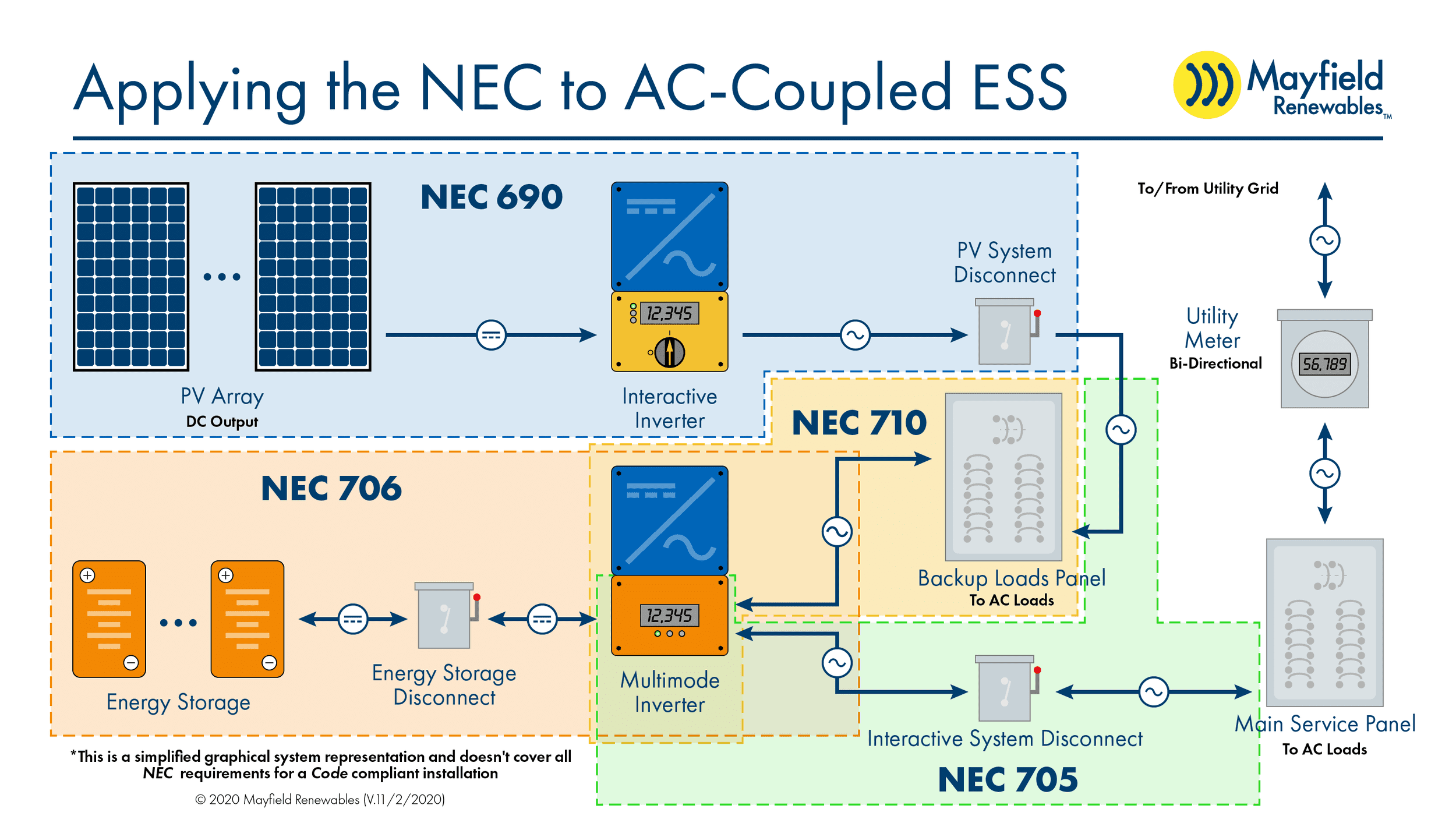Solar-Plus-Storage Systems and the NEC
With the rapid evolution of photovoltaic systems over the last few decades, the National Electrical Code (NEC) has been tasked with “keeping up” with new solar markets, equipment and system innovations, and fire protection goals. Every three years, a new NEC book is released and along with it a rush from PV system designers and integrators to understand any new requirements and the implications to systems they will be responsible for. And while solar-plus-storage systems are not new in the PV industry—in fact, that is where the solar industry was focused during the early years–the new wave of lithium-ion energy storage systems (ESS) has caused the NEC to quickly adopt new (or rethink old) requirements. As a result, solar industry professionals may be finding themselves flipping back and forth through the Codes easily getting confused on which Code sections they need to be looking to for requirements. Here we outline the most commonly applicable Code sections for today’s energy storage systems (ESS).

NEC Article 706 Energy Storage Systems
Article 706 applies to systems that utilize energy storage systems as part of their normal operating conditions. This Code article came into existence starting with the 2017 cycle and currently dictates ESS product listing (i.e. UL9540/A); disconnecting means; installation requirements (such as ESS working space and a directory); DC voltage limitations; circuit sizing; overcurrent protection; and charge control requirements. Notable requirements here include a readily accessible disconnect means for the ESS outside the building for one- and two-family dwellings (NEC 2020), and a DC voltage limitation of 100VDC (or up to 600VDC where live parts are not accessible during routine ESS maintenance).
NEC Article 705 Interconnected Electric Power Production Sources
Article 705 applies if the energy storage system is interconnected to a primary power source, such as utility power. This Code article details the requirements for interconnecting to a primary power source, such as the equipment shall be listed (or evaluated) for interactive function, and shall automatically stop exporting to and disconnect from the grid when there is a loss of this primary power source. Article 705 also covers the identification of power sources, defines micro-grid systems, and the requirements for connection and reconnection between the micro-grid system and the primary power source, additionally transitioning between “island mode” and interactive mode are laid out. New for the 2020 edition is a section, 705.13, for power control systems (PCS), which provides requirements for the PCS if it is used to limit current and loading on busbars and conductors.
NEC Article 690 Solar Photovoltaic (PV) Systems
Article 690 applies if the energy storage system is charged by PV. Before Article 706 was introduced in the 2017 edition of the NEC, Part XIII existed in Article 690, specifically for storage batteries, so designers were used to referencing this part for requirements such as battery storage installation, disconnects, overcurrent protection, and charge control. Now systems that are utilizing a modern ESS will go by Article 706, and those systems utilizing classic battery storage (such as lead acid battery banks) will reference Article 480 Storage Batteries (and possibly Article 706 if those storage batteries are part of an ESS). Regardless of this shift, obviously Article 690 still dictates the requirements for the PV side of the system. Additionally, there are a few specific requirements designers will need to pay special attention to for their systems employing energy storage. These sections include marking PV output conductors for polarity where they connect to energy storage systems, and rapid shutdown requirements. Because energy storage systems are commonly used to provide backup power when the grid goes down (and they are designed to keep the PV power flowing to charge batteries during those outage situations) designers need to make sure that the rapid shutdown device is on the PV side of the system. And not, for example, a disconnect at the utility interconnection point, which would simply mimic an outage and would not shut down the PV power flow.
NEC Article 710 Stand-Alone Systems
Article 710 applies to energy storage systems that will operate in “island mode”. This includes systems that operate completely independently from the grid (off-grid), and those interactive systems that provide backup power when there is a utility outage. Article 710 dictates the inverter input circuit current, output circuit sizing, and supply output requirements (for the loads that are being supplied power in island mode). Essentially this Code article allows the supply capacity to be less than the calculated cumulative load, but it must be at least equal to or greater than the largest single load. This Code article also allows for a single 120-VAC inverter to supply single-phase 120/240VAC distribution panels, as long as there are no multiwire branch circuits. Additionally there is a requirement for circuit breakers that are being backfed by the output of the inverter (that remains energized when pulled off the busbar) shall be secured, and that the voltage and frequency from our inverter output during “island mode” be suitable for the connected loads.
As ESS designers and integrators work through issues such as equipment selection, system configuration and component placement, labeling, conductors, overcurrent protection devices, and disconnects between components, they will need to become familiar with all of these Code sections and know where to look for requirements for each system section. The graphic provided at the top of the article is a good starting point, for a generic AC-coupled system, and it is important to note that more than one Code section will often apply to a single portion of the system.










